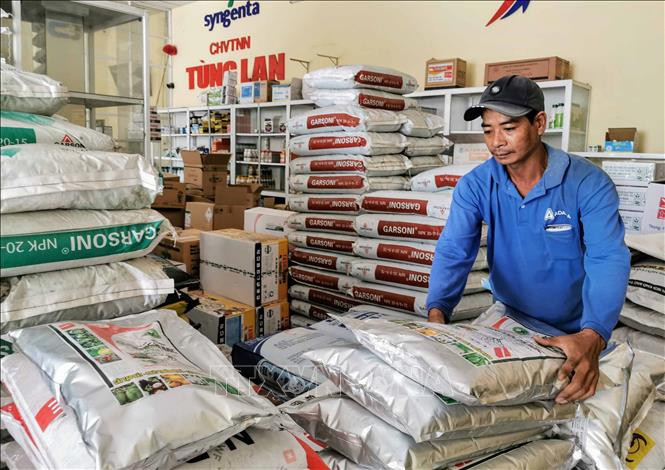Contrary to the annual seasonal rules, the price of the leading fertilizer in the market, urea, continues to decrease despite entering the winter-spring crop.

With such fluctuations in fertilizer prices, agricultural production is benefiting the most as export prices of agricultural products remain stable at high levels.
Actual market surveys show that from the end of November until now, although the demand for fertilizer consumption in the Mekong Delta is gradually increasing as the crop season begins and the prices of urea in Vietnam are on a downward trend compared to previous weeks, purchasing power is still slow because buyers are concerned about the risk of further price declines.
According to Ms. Nguyen Thi Tieu, Director of Ha Anh Import-Export Company, the non-seasonal decrease in domestic urea prices is due to many reasons. First of all, the domestic urea market is closely linked to the world market, so the selling price is similar. Although China - the world's largest urea producer - still maintains export restrictions, the supply of urea from Russia and the Middle East is very large, so the price of imported urea at this time has decreased significantly.
In addition, with such a downward price trend, farmers are not buying fertilizer reserves for the 2023-2024 Winter-Spring crop as they have done in previous years. In addition, with the domestic urea supply covering all fertilizer demand for agricultural production and remaining surplus for export, domestic urea prices are unlikely to increase during the crop season as has been the case in the past.
Regarding production activities, on November 27, Ninh Binh Fertilizer Plant temporarily stopped production for about 7-10 days to fix the problem. However, other urea production plants of Ha Bac Fertilizer, Phu My Fertilizer, and Ca Mau Fertilizer are still operating stably and all have abundant inventories. In addition, the Northern region has not yet entered the main winter-spring rice crop, so the suspension of Ninh Binh Fertilizer Plant does not significantly affect the general market.
According to the Vietnam Fertilizer Association, the current capacity of the four largest urea fertilizer factories in Vietnam belonging to the Vietnam Oil and Gas Group (Phu My Fertilizer, Ca Mau Fertilizer) and the Vietnam Chemical Group (Ha Bac Fertilizer, Ninh Binh Fertilizer) is about 2.6 million tons/year, while domestic consumption demand is only about 1.8 million tons/year. Therefore, the supply of domestically produced urea is still abundant, meeting enough fertilizer demand for the Winter-Spring crop even without imported urea.
The Director of Ha Anh Import-Export Company also said that in the past two years, the company has almost not imported urea but has completely switched to consuming fertilizer from the two factories Dam Ca Mau and Dam Phu My due to the large, stable supply, good quality, competitive prices and convenient distribution.
Regarding export activities, the cumulative export in November was estimated at 9 thousand tons, down about 33 thousand tons compared to October - the lowest export level since April 2020. According to many first-level fertilizer dealers, the 2023-2024 Winter-Spring rice crop was later than expected, coupled with the decrease in fertilizer exports and the second-level fertilizer dealer warehouses in the Southwest region still had inventory in November. Therefore, people did not buy all at once for the total demand of the whole crop but bought in small batches for fertilizer use due to knowing that urea prices were decreasing.
Currently, the world urea price has decreased by 8-20 USD/ton compared to last week, international traders have offered prices for Southeast Asian urea bulk cargo (bulk urea) delivered to Saigon port in the last week of November, down 10-15 USD/ton compared to the previous week. Accordingly, the decrease in import urea prices has strongly impacted domestic prices. With the pressure to release goods from fertilizer import ships in November, the offer price to Ho Chi Minh City is currently at 360-370 USD/ton CFR (CRF price is the price at the border gate of the exporting party and shipping costs) while the import price is above 420 USD/ton CFR. With this pressure, key domestic urea factories have announced a price reduction of about 500 VND/kg.
In the domestic market, the price of urea imported from Brunei, Indonesia and China fluctuated around 9,400-9,600 VND/kg. Meanwhile, the domestic urea price remained at 10,200 VND/kg-10,700 VND/kg for Ca Mau urea; 9,700 VND/kg-10,400 VND/kg for Phu My urea; 9,500-9,650 VND/kg for Ninh Binh urea and 9,600-9,700 VND/kg for Ha Bac urea.
According to customs data, urea imports in November reached about 30.5 thousand tons, down 10 thousand tons compared to October. At Lao Cai border gate, there has been no Chinese urea clearance yet. In December, it is expected that 2 Malaysian urea ships of Vinacam will be delivered to Vietnam in the first half of the month. Import activities in December are not expected to be vibrant because the downward trend in world urea prices in November did not attract importers to sign new orders. Import volume in December is expected to reach 10 thousand tons, down 20 thousand tons compared to November imports.
It is expected that in December, factories in the North may face pressure due to weak demand as the winter-spring crop may start from mid-January to February. Meanwhile, factories in the South are expected to maintain stable production. With this forecast, the amount of urea produced in December is estimated at 200 thousand tons, down 10 thousand tons compared to November.
According to VNA